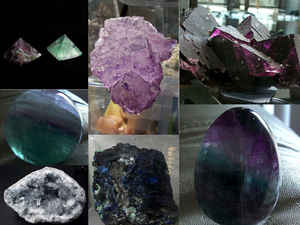
State Minerals
Official State Minerals
State Minerals Designations
States in the U.S. which have significant mineral deposits often create a state mineral, rock, stone or gemstone to promote interest in their natural resources, history, tourism, etc. Not every state has an official state mineral, rock, stone and/or gemstone, however.
Mineral is any naturally occurring, three dimensional, inorganic substance or compounds, with a chemical structure that can be exact, or can vary within limits. Elements that occur naturally are also listed as minerals. There are a few substances that lack one of these definitions but are still generally classified as a mineral, such as Opal, which lacks a definitive chemical structure. A mineral has an ordered atomic structure. It is different from a rock, which can be an aggregate of minerals or non-minerals and does not have a specific chemical composition. The exact definition of a mineral is under debate, especially with respect to the requirement a valid species be abiogenic, and to a lesser extent with regards to it having an ordered atomic structure. The study of minerals is called mineralogy.
Minerals can be described by various physical properties which relate to their chemical structure and composition. Common distinguishing characteristics include crystal structure and habit, hardness, lustre, diaphaneity, colour, streak, tenacity, cleavage, fracture, parting, and specific gravity. More specific tests for minerals include reaction to acid, magnetism, taste or smell, and radioactivity.
At least 22 of the 50 states have designated an official state mineral.Also, a state's official state rock may be a mineral, just as one of the minerals in this list is actually a rock. And a state's official mineral may be confused with its official gemstone. Be sure to check those lists,
In the chart below, a year which is listed the year during which that mineral was officially adopted as a State symbol or emblem
Minerals, & Gems

Gemstone, Minerals, Rocks




